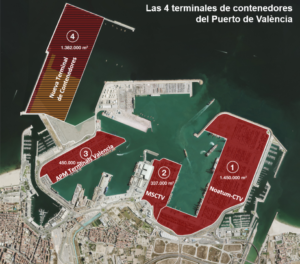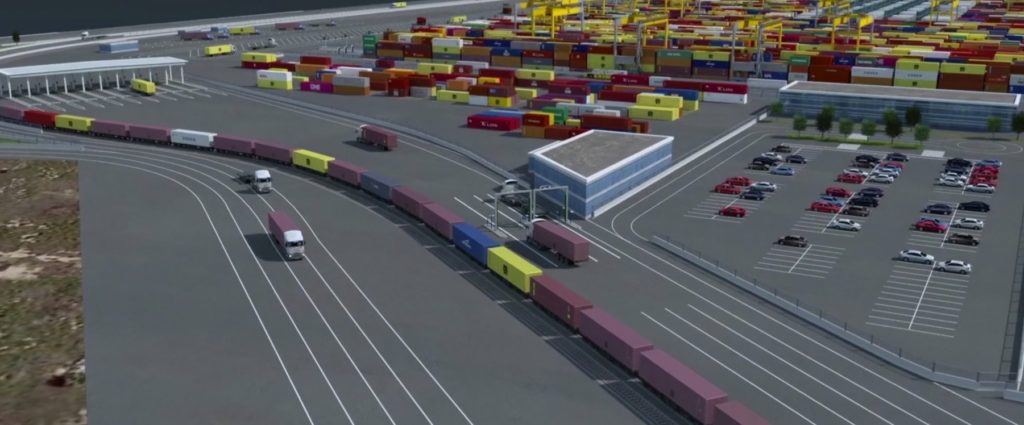
In its investment project, the company TIL (MSC group) is making a strong commitment to rail intermodality: transport of goods by train/ship
The terminal will have a 1 km long track bed with a capacity for 6 trains. It is the most ambitious electrified rail project inside a port of those currently planned in the world
The terminal will boost the economic activity of the Valencian Community and Spain
The economic impact of the port of València, once the new terminal is completed, will represent in terms of added value 2.27% of the whole of the Valencian Community and employment will exceed 44,000 jobs, with an average salary of around 32,000 euros per year
Each euro invested in the equipment of the new northern terminal will generate a total effect of 1.56 euros in the productive fabric of the Valencian economy
València, May 1st, 2021.- The container terminal planned for the inland waters of the northern extension of the Port of Valencia is a clear example of an infrastructure that combines sustainability and growth. On the one hand, the new terminal will be the most environmentally advanced in the world, and on the other hand, it will contribute to generating employment and wealth in the Valencian Community and Spain. This infrastructure will strengthen Valenciaport’s position in the Mediterranean and its role as a driving force in the Spanish economy.

In terms of the environment, the new container terminal will be a smoke-free space, as it will minimise CO2 emissions by supplying electricity to cranes and yard machinery, and to container ships. The project presented by TIL/MSC to Valenciaport includes the electrification of 98% of the driving components and installations of the terminal; and in addition, 100% of the electricity will come from renewable sources, which in turn will imply a 98% reduction in CO2 emissions.
Along these lines, the high level of automation of the equipment and operations, the use of advanced traffic prediction systems, the design of the buildings with energy efficiency criteria, and the external lighting system with LED-type luminaires will enable energy consumption to be minimised. This project is part of the “Valenciaport 2030, Zero Emissions” objective, which is based on actions that include a firm and decisive commitment to the implementation of renewable energies with investments in wind and photovoltaic energy, the construction of a new electrical substation that will allow ships docked in the port to be connected to the grid, the implementation of hydrogen projects in port facilities and machinery, and plans for the supply of LNG to ships.
Commitment to intermodality
In its project, TIL makes an important commitment to intermodality and offers to develop a railway terminal equipped with 6 tracks of 1,000 metres in length, with a capacity to move 305,000 TEUs/year by rail.
In addition, the automation of certain processes of the infrastructure will mean the creation of a technological cluster around it with the consequent creation of highly qualified employment.
The new container facility will create new qualified jobs and will boost the economic activity of the Valencian Community and Spain. The terminal will involve an investment of close to 1,400 million euros: up to 400 million public (with public financing which will be guaranteed and covered by the Port through its daily operations) and 1,021 million private (committed by TIL in its Investment Plan). All this will generate an important economic impact both in the construction phase and when it comes into operation.

UPV Impact Study
According to the study on the impact of the new Container Terminal of the North Extension of the Port of Valencia, carried out by the Institute of Transport and Territory (ITRAT), under the direction of Vicent Esteban Chapapría, Professor of Ports and Coasts at the Higher Technical School of Civil Engineering, in 2030, with the new terminal fully operational, the economic impact of the port of Valencia will represent in terms of added value 2.27% of the whole of the Valencian Community and employment will exceed 44,000 jobs, the average salary of which will be around 32,000 euros per year. 44,000 jobs, the average salary of which will be around 32,000 euros per annum. Overall, the port of Valencia will account for 2.2% of all employment in the Comunidad Valenciana.
This study was presented in February 2020 and was the result of collaboration between the Universitat Politècnica de València (UPV), the Valencian Business Confederation (CEV), the Chamber of Commerce of Valencia and the business association, Propeller Valencia.
Among its final considerations, and in terms of employment, it was concluded that:
- Each euro invested in the equipment of the new north terminal will generate a total effect of 1.56 euros in the productive sectors of the Valencian economy.
- The new Port infrastructure will allow the creation of a total of 17,017 new jobs in the period 2022-2023 and 15,284 jobs between 2024-2026.
- On a social level, the impact will be very significant: directly, in 2023, the Port of Valencia will generate 18,461 jobs in addition to those of the port community itself, a figure which will be higher (19,800) in 2025.
- In indirect terms, the employment created will also be important: in the two years of analysis, more than 4,200 workers will be employed in 2023 and 2025.
- The induced effect, which is less than the direct effect, will reach figures of around 13,000 jobs in each year analysed. These jobs can be considered stable and lasting over time.
- During these years, there will be an overlap of activity: on the one hand, the development of the terminal and, on the other hand, the activity resulting from port traffic. Thus, if investments are made in a linear fashion and economies of scale are not exploited, the employment generated in 2023 could reach 44,000 jobs and in 2025 it would be close to 43,000 jobs.
- The economic impact of the investments for the equipment of the new northern terminal will mean a change in final demand in the construction sector. The planned investment of almost €1.5 billion will have a direct effect of more than €1.2 billion on the productive fabric (628.5 between 2022-2023 and 586.2 between 2024-2026).
- At an aggregate level, the results of the direct effect show a notable increase in the volume of wages and salaries and in business profits, 214.3 and 281.5 M€ respectively in the period 2022-2023, and 199.9 and 262.5 M€, respectively, for the period 2024-2026.
- The economic aggregates of the indirect effect reveal that wages have a significant weight in gross value added. The volume of the induced effect (388 M € in gross value added in 2022-2023) is higher than that of the indirect effect (155 M € in GVA in 2022-2023), but without reaching the levels of the direct effect (519 M € in GVA in 2022-2023).
- Furthermore, the gross value added of the Valencian economy will experience an increase of more than €2,000 M in 2022-2026, with a generation of tax revenues of around €85.79 M.
- The total economic impact of the port of Valencia when the terminal is partially active has been calculated using official traffic forecasts. This has made it possible to estimate that in 2023 the port’s activity will exceed €1.6 billion and in 2025 it could exceed €1.8 billion. The results reveal that directly, the port of Valencia will generate an increase in gross added value of 1,186 and 1,321 M€ in 2023 and 2025 respectively, where salaries will have the greatest weight, an issue which is repeated in the indirect and induced effect. The sum of all of them adds up to a total effect of €1,021 and €1,138 million in terms of wages, while gross profits will reach €966 and €1,076 million in 2023 and 2025. The increase in total gross value added will represent around 1.9% of the gross value added of the Valencian Community.

